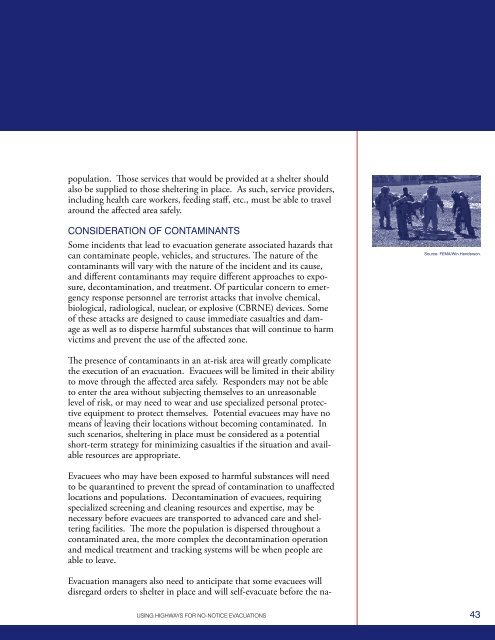using highways for no-notice evacuations - FHWA Operations - U.S. ...
using highways for no-notice evacuations - FHWA Operations - U.S. ...
using highways for no-notice evacuations - FHWA Operations - U.S. ...
You also want an ePaper? Increase the reach of your titles
YUMPU automatically turns print PDFs into web optimized ePapers that Google loves.
population. Those services that would be provided at a shelter shouldalso be supplied to those sheltering in place. As such, service providers,including health care workers, feeding staff, etc., must be able to travelaround the affected area safely.CONSIDERATION OF CONTAMINANTSSome incidents that lead to evacuation generate associated hazards thatcan contaminate people, vehicles, and structures. The nature of thecontaminants will vary with the nature of the incident and its cause,and different contaminants may require different approaches to exposure,decontamination, and treatment. Of particular concern to emergencyresponse personnel are terrorist attacks that involve chemical,biological, radiological, nuclear, or explosive (CBRNE) devices. Someof these attacks are designed to cause immediate casualties and damageas well as to disperse harmful substances that will continue to harmvictims and prevent the use of the affected zone.Source: FEMA/Win Henderson.The presence of contaminants in an at-risk area will greatly complicatethe execution of an evacuation. Evacuees will be limited in their abilityto move through the affected area safely. Responders may <strong>no</strong>t be ableto enter the area without subjecting themselves to an unreasonablelevel of risk, or may need to wear and use specialized personal protectiveequipment to protect themselves. Potential evacuees may have <strong>no</strong>means of leaving their locations without becoming contaminated. Insuch scenarios, sheltering in place must be considered as a potentialshort-term strategy <strong>for</strong> minimizing casualties if the situation and availableresources are appropriate.Evacuees who may have been exposed to harmful substances will needto be quarantined to prevent the spread of contamination to unaffectedlocations and populations. Decontamination of evacuees, requiringspecialized screening and cleaning resources and expertise, may benecessary be<strong>for</strong>e evacuees are transported to advanced care and shelteringfacilities. The more the population is dispersed throughout acontaminated area, the more complex the decontamination operationand medical treatment and tracking systems will be when people areable to leave.Evacuation managers also need to anticipate that some evacuees willdisregard orders to shelter in place and will self-evacuate be<strong>for</strong>e the na-USING HIGHWAYS FOR NO-NOTICE EVACUATIONS43
















